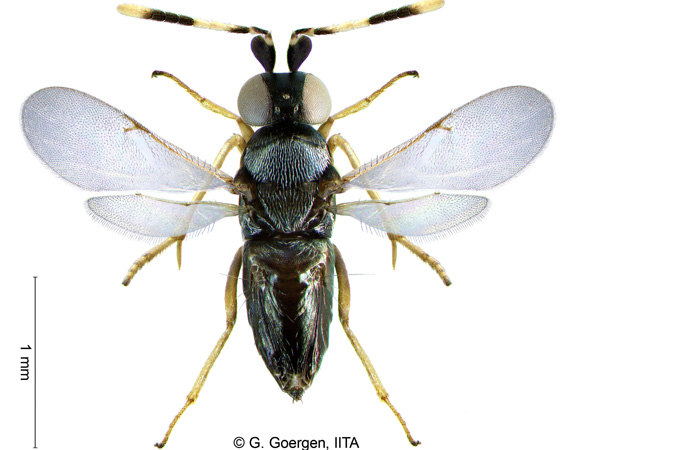Tiny wasps deployed to kill crop-eating pests
Indonesia’s cassava plantations are being killed by mealybugs, and thousands of wasps will be released to stop them.

Scientists will release 3,000 parasitoid wasps in a cassava plantation in the Indonesian city of Bogor, hoping they will prey on the pink mealybug pest that has devastated the crop, the second-most-consumed starch in Indonesia.
The mealybug, a sap-sucking insect originally from South America, thrives in tropical climates and reproduces year-round. Each female lays about 500 eggs at a time, resulting in up to 15 new generations of the bugs annually.
Keep reading
list of 4 itemsAfter the Hurricane
World’s coral reefs face global bleaching crisis
Why is Germany maintaining economic ties with China?
“If not brought under control [in Indonesia], this invasive pest has the potential to considerably reduce cassava yield as it previously did in Thailand and elsewhere in the Asia region,” said Johannes Willem Ketelaar, the integrated pest management specialist for vegetables with the Food and Agricultural Organization (FAO) in the Asia-Pacific region.
 |
| A photo of the parasitoid wasp released by the International Center for Tropical Agriculture [AP] |
Parasitoid wasps lay eggs inside the mealybug – and when the eggs hatch as larvae, the mealybug implodes. The strategy has been successfully used before to address a mealybug infestation in Thailand in 2010, as well as in Africa’s cassava belt, where the pest population was reduced to less than 10 percent of its peak, according to the Consultative Group on International Agricultural Research Centres (CGIAR).
But repeated introductions of new crops and species to foreign ecosystems were what created the mealybug problem in the first place. Neither the insect nor cassava are indigenous to the Greater Mekong subregion, which includes Thailand, Indonesia, Cambodia, Laos, Myanmar, Vietnam, and China’s southern Yunnan province.
“There is always a risk of unintended consequences when introducing a new species into an ecosystem,” said Laura Kahn, a physician and co-founder of the One Health Initiative, a scientific research movement investigating interaction among humans, animals and ecosystems.
Nevertheless, using the parasitoid wasps as a form of biocontrol is more environmentally sound than pesticides, scientists say, and has a proven track record.
Taking over, ‘alien-style’
Indonesian cassava farmers first sighted the mealybug in 2010. The pests infected entire plantations in Lampung and Java by 2014, according to Aunu Rauf, an entomologist at Bogor Agricultural University.
Mealybugs slowly perish and completely die within about two weeks, while the parasitoid wasp develops and feeds inside the mealybug body.
“The farmers did not know how to contain it. They tried to cut the tips off the leaves, but it wouldn’t stop spreading,” said Rauf.
Scientists at the International Centre for Tropical Agriculture (CIAT) and FAO, in partnership with the Bogor Agricultural University, decided to introduce the wasps.
With heads the size of pins, the two-millimetre-long wasps use the mealybug’s body as a host by implanting their eggs inside and growing into larvae, eventually taking over the plant-sucking pests, “alien-style”, according to Kris Wyckhuys, a cassava entomologist at CIAT based in Hanoi.
“Following parasitism, mealybugs slowly perish and completely die within about two weeks, while the parasitoid wasp develops and feeds inside the mealybug’s body,” Wyckhuys explained.
It will take two years to bring down the mealybug population using the wasps, which scientists hope will adapt to local conditions and reproduce to initiate a long-term, full-fledged assault on mealybugs, which otherwise could become more resilient because of temperature increases associated with climate change.
Better than pesticides
The use of parasitoids, or parasite-like organisms that develop inside other life forms and later kill them, is more effective, safe and sustainable than pesticides, especially in Southeast Asia where farmers often do not use protective equipment, according to the FAO.
“Use of pesticides are often ineffective, contaminate the environment, can result in secondary pest outbreaks and can be hazardous for the applicator’s health,” said Ketelaar.
 |
| Agricultural officers prepare to release parasitoid wasps at a cassava field in Bogor, Indonesia [AP] |
In addition, the waxy substance covering the mealybug’s body acts as an armour against insecticide, while the toxic poison is likely to kill other beneficial insects including the wasps, according to Rauf.
According to the FAO, for the wasp deployment to be successful, “farmers must stop use of pesticides”, stressed Ketelaar.
The study conducted before the wasp release did not find any potential negative side effects on Indonesian flora and fauna, noted CIAT’s Wyckhuys, who added the wasps have never been known to host in other species besides mealybugs.
But given that 75 percent of all emerging infectious diseases originate in the animal world – often when exotic species are introduced to a new place – risks cannot be completely ruled out, said Kahn.
For example, Kahn said, “white nose syndrome, the fungal disease that is decimating the little brown bat population in the US, was probably introduced by [a European species]. Hopefully nothing bad will happen with the wasps, but you never know.”
Entomologists, however, say the greater risk is that the initiative will not work, because of the use of pesticides or unforeseen wasp predators.
“The huge task of tackling the mealybug problem is just starting, and lots of work remains to be done,” concluded Wyckhuys.